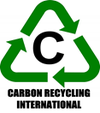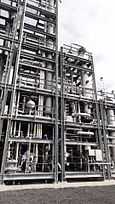Carbon Recycling International
 | |
| Private | |
| Industry | Renewable fuels |
| Founded | 2006 |
| Headquarters | Reykjavík, Iceland |
Key people |
KC Tran (Co-founder and CEO) Omar Sigurbjornsson (Research) Benedikt Stefansson (Business Development)[1] |
| Products | Renewable methanol |
| Website |
CRI |
Carbon Recycling International Inc. (CRI) is an Icelandic renewable methanol company. Its emissions-to-liquid process uses carbon dioxide and water and electricity to create methanol fuel.[2][3]
History
CRI, incorporated in 2006, was founded by Fridrik Jonsson, Art Shulenberger, Oddur Ingolfsson, and KC Tran.[4] Partners include Olís, HS Orka, Grindavík municipality, Mannvit Engineering,[5] and Innovation Center Iceland.[6]
CRI's first commercial scale plant, the George Olah Plant (named after George Andrew Olah,[7] the Nobel Prize Laureate), was completed in 2011.[8]
Renewable methanol
Renewable methanol is methanol derived from renewable energy.[9] It can be blended into transportation fuel or processed as a chemical feedstock. RM is also a viable input for biodiesel production. Fuel blends range from RM3 (3% methanol and 97% other) to RM100 (100% methanol with trace additives). High percentage blends can be used with flexible-fuel vehicles (FFVs), while low percentage blends can be used in existing cars.[10] CRI is interested in increasing the number of flex-fuel cars in Iceland and supplying RM85.[11]
Usage concerns
Alcohols, including methanol and ethanol, can be corrosive to certain materials in some vehicles. Replacement parts may be necessary for higher blends, but most modern cars are capable of using low blends of methanol.
Production

Production of renewable methanol is similar to that of conventional methanol, except that carbon dioxide is substituted for carbon monoxide and hydrogen is produced by electrolysis of water.
RM has no connection to agriculture, as water, electricity, and carbon dioxide are the primary inputs of its production process. Production of RM is less vulnerable to changes in feedstock prices.[12]
Plants
The George Olah Plant, or the GO Plant, has a capacity of 5 million liters per year, but is currently equipped for only 2 million liters.[13] It is located close to the Blue Lagoon and Svartsengi power station. The plant is expected to use around 85% of the carbon dioxide produced by Svartsengi power station.[14]
Legislation
The European Union's renewable energy directives consider RM to be a renewable fuel, making it a candidate for the EU's renewable fuel blending mandates.[15]
Impact
Carbon dioxide is a major component of global warming. By removing carbon dioxide from industrial emissions, CRI's process could help mitigate environmental impact. Renewable methanol burns cleanly as a fuel, but it has trace amounts of impurities.
CRI's process can also be used to store energy in the form of methanol, especially in cases where the energy source is inconsistent. For example, wind and solar power are irregularly available.[16][17] Methanol is also a good energy carrier, being less volatile and easier to store than hydrogen.
Future projects
CRI plans to implement standardized CSPs (commercial scale plants), each with a capacity of 50 million liters per year.[18]
CRI may build a 100 ML[19] plant in Húsavík, having signed a memorandum of understanding with power company Landsvirkjun.[20]
CRI has also entered into a memorandum of understanding with Altona Energy Plc. concerning a potential project using hydrogen byproduct as a feedstock.[21]
See also
References
- ↑ "Management". Carbon Recycling International. Retrieved 11 July 2012.
- ↑ "Technology". Carbon Recycling International. 2011. Retrieved 11 July 2012.
- ↑ "Framleiðsla hafin á nýju vistvænu eldsneyti". Morgunblaðið. Retrieved 24 July 2012.
- ↑ "About Us". Carbon Recycling International. Retrieved 11 July 2012.
- ↑ "Exclusive agreement signed with Carbon Recycling International". Mannvit. 2008. Retrieved 12 July 2012.
- ↑ "Partners". Carbon Recycling International. Retrieved 11 July 2012.
- ↑ Matthew Knight. "Electric car concept drives progress with extended 500-mile range". CNN. Retrieved 24 July 2012.
- ↑ "First Commercial Plant". Carbon Recycling International. Retrieved 11 July 2012.
- ↑ "First Commercial Plant". Carbon Recycling International. Retrieved 11 July 2012.
- ↑ "Products". Carbon Recycling International. Retrieved 13 July 2012.
- ↑ "Eldsneyti úr útblæstri". RÚV. Retrieved 24 July 2012.
- ↑ "Products". Carbon Recycling International. Retrieved 13 July 2012.
- ↑ "First Commercial Plant". Carbon Recycling International. Retrieved 11 July 2012.
- ↑ Paul Fontaine (28 February 2012). "Carbon Recycling In Effect Near Blue Lagoon". The Reykjavík Grapevine. Retrieved 24 July 2012.
- ↑ "First Commercial Plant". Carbon Recycling International. Retrieved 11 July 2012.
- ↑ Wind Systems Integration Basics
- ↑ Carr (1976), p. 85
- ↑ "First Commercial Plant". Carbon Recycling International. Retrieved 11 July 2012.
- ↑ Eygló Svala Arnarsdóttir. "Mainstreaming the Alternative (ESA)". Iceland Review. Retrieved 24 July 2012.
- ↑ Omar Valdimarsson. "Alcoa Unlikely To Build Smelter In North Iceland, Visir Reports". Bloomberg. Retrieved 24 July 2012.
- ↑ "Altona Energy Plc. Enters Into Memorandum Of Understanding With Carbon Recycling International". Reuters. Retrieved 24 July 2012.